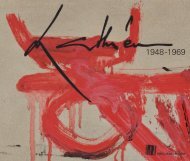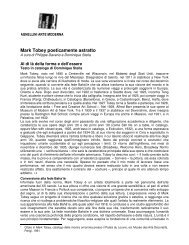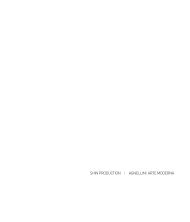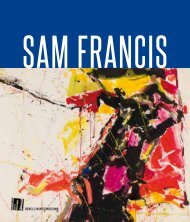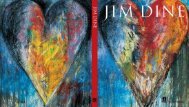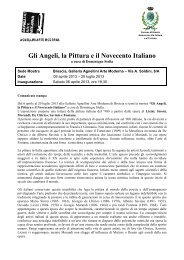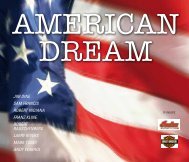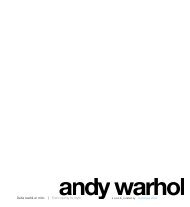Shin production | Agnellini Arte ModernA - Galleria Agnellini Arte ...
Shin production | Agnellini Arte ModernA - Galleria Agnellini Arte ...
Shin production | Agnellini Arte ModernA - Galleria Agnellini Arte ...
You also want an ePaper? Increase the reach of your titles
YUMPU automatically turns print PDFs into web optimized ePapers that Google loves.
3 citato in Aimé, Jacqueline,<br />
l’aventure prométhéenne de<br />
georges Mathieu, pag. 59, ed. du<br />
garde-temps, parigi, 2005<br />
3 cited in Aimé, Jacqueline,<br />
l’Aventure prométhéenne de<br />
georges Mathieu, p. 59, paris,<br />
ed. du garde-temps, 2005<br />
rosenberg ha definito Action painting, una pittura gestuale che richiede un coinvolgimento<br />
fisico dell’artista con la superficie dell’opera. e, come sottolinea tobey, la pace interiore e la<br />
meditazione non presiedono alla creazione; al contrario, alla base dell’azione creatrice vi è<br />
un’irrequietudine corporea e un’esaltazione mentale lontane dai precetti ai quali tobey aderisce.<br />
in europa, alcuni rappresentanti dell’Astrazione lirica mostrano parallelismi più evidenti con i<br />
suoi concetti fondamentali. georges Mathieu, in particolare, ha arricchito la sua opera con la<br />
conoscenza della calligrafia e dell’arte giapponese. tramite i suoi amici imaï e teshigahara, egli<br />
si era avvicinato a questa filosofia di cui comprendeva l’interesse superiore, definendo se stesso<br />
un “calligrafo intuitivo”. nella Abstraction prophétique Mathieu sottolinea i legami profondi che<br />
uniscono l’oriente e l’occidente, e affronta l’aspetto di complementarità dei pensieri occidentale e<br />
orientale: “lo Zen, via dell’illuminazione repentina, ci invita a cogliere la Verità come un’intuizione<br />
diretta e non come un’astrazione intellettuale. non derivando dal ragionamento, essa appare<br />
come una presenza, una visione nel vuoto, che suscita una morale dinamica vicina (…) a queste<br />
parole del Maestro eckart: “più che me stesso, io sono ciò che mi assorbe” 3 . così, l’Astrazione<br />
lirica integra la nozione di rischio e suggerisce una disciplina e un’ascesi ignote alle estetiche<br />
anteriori del nostro occidente. nel 1957, georges Mathieu compì un viaggio decisivo in giappone,<br />
che confermò le sue intuizioni ma che gli rivelò anche “la grande distanza che ci separa da<br />
hand, certain followers of Abstraction lyrique in europe seem to have points in common<br />
with tobey’s fundamental concepts. georges Mathieu, among others, enriched his work<br />
with his knowledge of calligraphy and Japanese art. through the mediation of his friends<br />
imaï and teshigahara he had studied this philosophy, of which he understood its heightened<br />
importance, defining himself an “intuitive calligrapher”. in his Abstraction prophétique,<br />
Mathieu emphasises the bonds that unite east and West and tackles the complementarity<br />
of Western and eastern thought: “Zen, the steep path to enlightenment, invites us to grasp<br />
the truth like a direct intuition and not at all like an intellectual abstraction. not stemming<br />
from the thought processes, it appears like a presence, a vision in the void, bringing about<br />
a dynamic ethic close… to these words of Meister eckhart: “i am what absorbs me rather<br />
than myself” 3 . Abstraction lyrique integrates the notion of risk and suggests a discipline<br />
and an asceticism that did not exist in earlier Western aesthetics. in 1957 georges Mathieu<br />
made a critical trip to Japan that confirmed his intuitions, but during which he also<br />
understood “the immense distance that separates us from this people, probably the most<br />
refined in the world”. it is indeed difficult to attain the level of the millenary principles of<br />
such a complex civilisation. We can do no more than touch lightly on the most immediately<br />
accessible aspects, and to be aware of a force that, to us Westerners, remains mysterious<br />
m a r k t o b e y 28 29 m a r k t o b e y<br />
questo popolo, forse il più raffinato del mondo”. perché, in effetti, è difficile raggiungere i<br />
principi millenari di una civiltà così complessa. Si può solamente sfiorarne gli aspetti più<br />
immediatamente accessibili, avendo la coscienza di una forza che, per noi occidentali, resta<br />
misteriosa e incredibilmente lontana. Sia Mathieu che tobey sono stati apprezzati in giappone.<br />
il riconoscimento delle astrazioni occidentali da parte degli artisti giapponesi ha contribuito a<br />
determinare un’influenza reciproca. del resto, nel 1937 Saburô hasegawa pubblicò un libro<br />
intitolato l’Art abstrait (l’arte astratta, ndr) nel quale sottolineava già i legami fra l’arte astratta<br />
e la calligrafia. nel 1951, in una rivista specializzata della regione di Kyoto – bokubi (estetica<br />
dell’inchiostro, ndr) – presentò alcuni artisti occidentali fra cui Franz Kline, pierre tal coat e<br />
Mark tobey, preconizzando futuri progetti condivisi. Fu così che nella prima metà degli anni ‘50<br />
nacque in giappone una calligrafia non figurativa, che non rappresentava un carattere avente un<br />
significato letterale. come gli oggetti di ceramica privi di ogni funzione pratica e come le mostre<br />
di ikebana in cui non vengono utilizzati vegetali “viventi”, questa calligrafia fece parlare di sé<br />
come di una creazione rivoluzionaria.<br />
Sottolineiamo anche il ruolo svolto da Michel tapié, critico francese autore di un art autre<br />
(un’arte altra, ndr) e promotore dell’arte informale attraverso l’accostamento di artisti<br />
europei, americani e giapponesi quali tobey, Kline, Francis, dubuffet, Fautrier, Mathieu, Wols,<br />
and incredibly distant. like tobey, Mathieu was held in high esteem in Japan. the recognition<br />
of Western abstraction by Japanese artists helped to produce a mutual influence. As early<br />
as 1937 Saburô hasegawa published a book called l’art abstrait, in which he underlines<br />
the links that abstract art has with calligraphy. in a journal called bokubi (the aesthetics<br />
of ink, ndr) a specialised review from the region of Kyoto, in 1951 he introduced the work of<br />
Western artists, including Franz Kline, pierre tal coat and Mark tobey, envisaging that ties<br />
could be struck up with them. thus it was that in the first half of the 1950s a non-figurative<br />
calligraphy was born in Japan that did not use characters with a literal significance.<br />
Following the example of ceramic objects lacking any practical function, and ikebana<br />
exhibitions that made no use at all of “living” plants, this calligraphy became widely talked<br />
about as a revolutionary innovation.<br />
Also deserving mention is the role played by Michel tapié, a French critic who wrote un art<br />
autre and promoted informal art through the bringing together of european, American and<br />
Japanese artists, such as tobey, Kline, Francis, dubuffet, Fautrier, Mathieu, Wols, hartung,<br />
capogrossi, Fontana, burri, Accardi, les lettristes français, domoto, Arai, imai, onishi, Suzuki,<br />
teshigahara and the gutaï group. between 1950 and 1960 tapié essentially devoted himself<br />
to the cultural promotion of this “other art”, a current identified in 1952 at the heart of the



